
Climate change, whatever the cause, has profoundly affected human societies and the natural environment in the past. Throughout history there are examples of societal collapse associated with regional changes in climate, ranging from the decline of the Maya in Mexico (linked to drought) to the disappearance of the Viking community from Greenland in the fifteenth century (linked to decreasing temperatures). Some of these regional climate changes occurred rapidly, on timescales similar to current rates of global climate change.
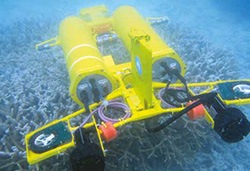
 by QCAT
by QCATThe clearest present-day impacts of climate change in Australia and elsewhere are seen in the natural environment, and are associated with warming temperatures and increases in the number, duration and severity of heatwaves. These impacts include changes in the growth and distribution of plants, animals and insects; poleward shifts in the distribution of marine species; and increases in coral bleaching on the Great Barrier Reef and Western Australian reefs. Some of these changes can directly affect human activities; for example, through the effects of changing distributions of fish and other marine organisms on commercial and recreational fisheries, and the impacts of coral bleaching on tourism.
Some regional changes in Australian rainfall have been linked to humaninduced climate change. Southwest Western Australia has experienced a reduction in rainfall since the 1970s that has been attributed, at least in part, to enhanced greenhouse warming (Question 3). Societal adaptation to the resulting shortfalls in water supply is possible and already occurring (Box 7.1).
Declining rainfall and surface reservoir recharge since the mid-1970s in southwest Western Australia have been linked to changes in atmospheric circulation that are consistent with what would be expected in an atmosphere influenced by increasing greenhouse gas concentrations. The Water Corporation of Western Australia is addressing the diminishing surface water resource by setting out to deliver a ‘climate-independent’ supply of water for domestic consumption through two desalination plants. These now have the capacity to provide around half the piped water supply for the wider Perth region at a cost several times greater than that of surface water.
The impacts of future climate change and related sea-level rise will be experienced in many areas, from the natural environment to food security and from human health to infrastructure.
Ecosystems: Among Australia’s terrestrial ecosystems, some of the most vulnerable to climate change are (1) alpine systems as habitats shift to higher elevations and shrink in area; (2) tropical and subtropical rainforests due to warming temperatures (moderated or intensified by rainfall changes); (3) coastal wetlands affected by sea-level rise and saline intrusion; (4) inland ecosystems dependent on freshwater and groundwater that are affected by changed rainfall patterns; and (5) tropical savannahs affected by changes in the frequency and severity of bushfires.
Climate warming causes land and ocean life to migrate away from areas that have become too warm, and towards areas that previously were too cool. In many places, climate change is likely to lead to invasion by new species and extinctions of some existing species that will have nowhere to migrate, for example because they are located on mountain tops (Figure 7.1). Seemingly small changes, such as the loss of a key pollinating species, may potentially have large impacts.
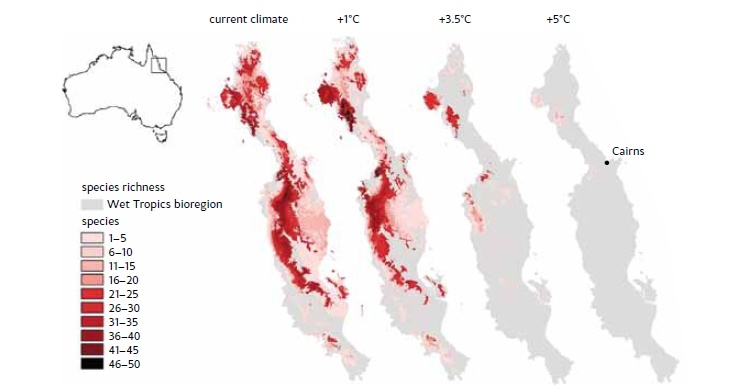
Carbon dioxide affects ecosystems directly, both positively and negatively. On land it enhances growth in some trees and plants, an effect sometimes called ‘CO2 fertilisation’. Absorption of CO2 into the oceans causes ‘ocean acidification’, impeding shell formation by organisms such as corals and causing coral deterioration or death.
Bushfires: The number of extreme fire risk days has grown over the past four decades, particularly in southeast Australia and away from the coast (Figure 7.2). Future hotter and drier conditions, especially in southern Australia, are likely to cause further increases in the number of high fire-risk days and in the length of the fire season. CO2 fertilisation may lead to increased foliage cover and hence increased fuel loads in warm arid environments such as parts of southern Australia. A study of southeast Australia has projected that the number of fire danger days rated at ‘very high’ and above could double by 2050, under high emission climate scenarios. Whether or not this leads to more, or worse, fires, and hence to changes in ecosystems, agriculture and human settlements, will depend on how this risk is managed.
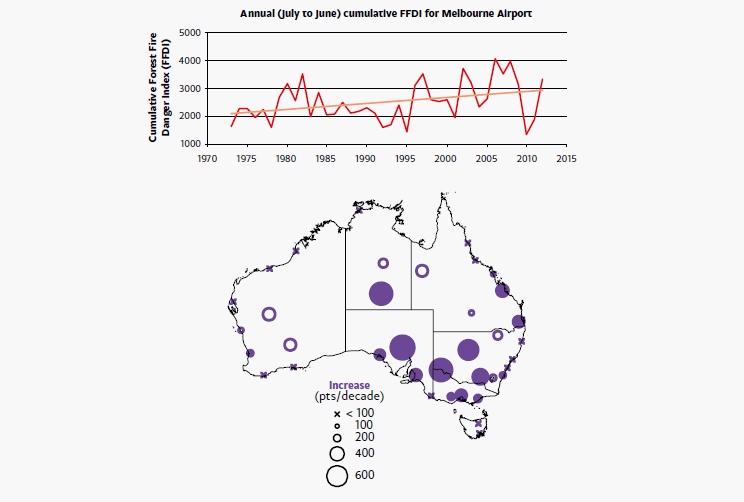
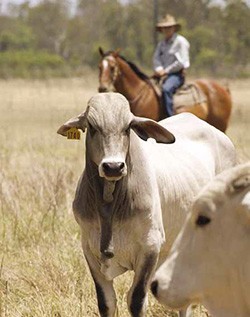
 by CSIRO
by CSIROFood security: In a non-drought year, around three-quarters of Australian crop and livestock production is exported. The range of adaptation strategies for primary producers to meet the challenge of climate change is large, including breed and seed selection, water conservation and changes in the timing of farm operations. Over the next few decades, some Australian agriculture may benefit from warmer conditions and from the fertilisation effect of increased CO2 in the atmosphere. Looking further into the future, much depends on the effects of climate change on rainfall regimes in Australia’s farming regions. If rainfall increases, climate change may continue to be beneficial for some agriculture. However, for drier, hotter, higher variability climate change scenarios, there are limits to adaptation with anticipated declines in crop yield and livestock production.
Health: Heatwaves are among the highest-impact climate events in terms of human health in Australia. In very hot conditions, people can suffer from heat stress, especially vulnerable individuals such as the sick and elderly. During the heatwave of early 2009 in Victoria, there were 374 more deaths than average for the time of year (Figure 7.3). Warmer temperatures in future will lead to increased occurrences of heatwaves (Figure 5.2 left). Without further adaptation, extremely hot episodes are expected to have the greatest impact on mortality in the hotter north, while in cooler southern Australia there is likely to be an offsetting reduction in the number of cold-season deaths.
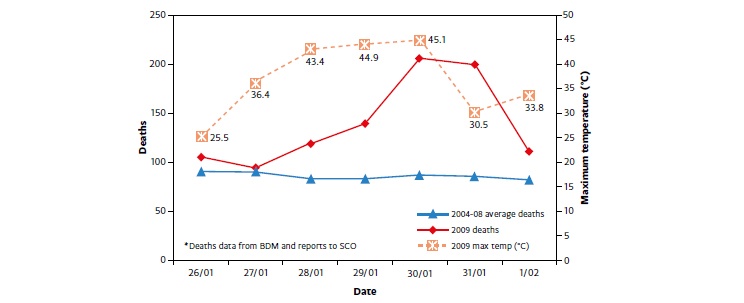
Warmer temperatures may lead to an increase in diseases spread via water and food such as gastroenteritis. Over the next few decades, Australia is expected to remain malaria-free. However, other vector-borne diseases such as dengue fever, Barmah Forest Virus and Ross River Virus may expand their range, depending on socioeconomic and lifestyle factors related to hygiene, travel frequency and destinations, in addition to climate scenarios. Extreme events also have psychological impacts. Drought is known to cause depression and stress amongst farmers and pastoralists, and this impact may increase over southern Australia as a result of climate change.

Infrastructure: Climate change can have impacts on infrastructure such as electricity and transport networks. Electricity demand rises sharply during heatwaves because of increased air conditioning. To avoid extensive blackouts there has been investment in generation and network capacity that is only used for a short time. In New South Wales, capacity needed for fewer than 40 hours a year (less than 1% of time) accounts for around 25% of retail electricity bills. In the 2009 heatwave in Melbourne, many rail services were cancelled because rails buckled and air conditioning failed. Coastal inundation and erosion due to sea-level rise, particularly when accompanied by extreme weather events, pose risks to infrastructure.
Around 30,000 km of roads across Australia are at risk from a 1.1 metre sea-level rise, with housing and infrastructure at risk valued at more than $226 billion.
In engineering terms, adapting to some of these risks is straightforward. Perth recently experienced a heatwave more intense than the Melbourne event, but no trains were cancelled on the city’s more modern rail network. However, the costs of adapting infrastructure can be high.
The impacts of climate change often act to amplify other stresses. For example, many natural ecosystems are already subject to urban encroachment, fragmentation, deforestation, invasive species, introduced pathogens and pressure on water resources. Some societies suffer warfare and civil unrest, overpopulation, poverty and sinking land in high population river deltas. Multiple stresses do not simply add to each other in complex systems like these; rather, they cascade together in unexpected ways. Therefore, climate change impacts, interacting with other stresses, have the potential to shift some ecosystems and societies into new states with significant consequences for human wellbeing. For moderate levels of climate change, developed countries such as Australia are well placed to manage and adapt to such cascading impacts. However, developing nations, especially the least developed, face risks from projected impacts that may exceed capacities to adapt successfully. As climate change intensifies, especially under high-emission pathways (Question 4), adaptive capacities may be exceeded even in developed countries.
Human society is now globally interconnected, dependent on intricate supply chains and a finite resource base. The global population now exceeds 7 billion people and is expected to increase to 9.6 billion by 2050; half of all fresh water and almost a quarter of global plant productivity is appropriated for human use; forecast yield gaps for major crops are increasing, especially in developing countries, and some yields may be reaching biophysical limits; 145 million people live within one metre elevation of sea level, with around 72% of these in Asia.
In this interconnected world, many risks to Australia from climate change, and potentially many opportunities, arise from impacts outside our national borders. For example: (1) sea-level rise and extreme events will threaten coastal zones, Pacific small island states, and large urban centres in Asian megadeltas; (2) global food production and trading patterns will change as present-day exporters see production fall, and as new exporters emerge; (3) climate change may exacerbate emerging humanitarian and security issues elsewhere in the world, leading to increased demands on Australia for aid, disaster relief and resettlement.
The further global climate is pushed beyond the envelope of relative stability that has characterised the last several thousand years, the greater becomes the risk of major impacts that will exceed the adaptive capacity of some countries or regions. Australia is a wealthy, healthy and educated society well placed to adapt to climate change and with the capacity to help address the impacts of changing climates elsewhere in the world.
© 2025 Australian Academy of Science